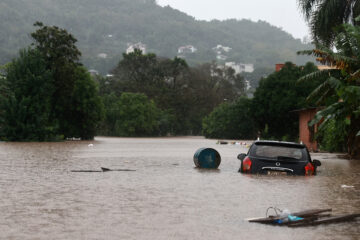Typhoon tears down homes in disaster-weary Philippines
Typhoon Hagupit tore apart homes and dumped fierce rains across the eastern Philippines on Sunday, killing at least two people while creating more misery for millions after a barrage of deadly disasters.
The typhoon roared in from the Pacific Ocean and into remote fishing communities on Samar island on Saturday night with wind gusts of 210 kilometres (130 miles) an hour, local weather agency Pagasa said.
The wind strength at landfall made Hagupit the most powerful storm to hit the Philippines this year, exceeding a typhoon in July that killed more than 100 people.
"Many houses, especially in the coastal areas, were blown away by strong winds," Stephanie Uy-Tan, the mayor of Catbalogan, a major city on Samar, told AFP by phone on Sunday.
"Trees and power lines were toppled, tin roofs were blown off and there is flooding."
Fearful of a repeat of last year when Super Typhoon Haiyan claimed more than 7,350 lives, the government undertook a massive evacuation effort ahead of Hagupit that saw millions of people seek shelter.
Authorities said the efforts, described the United Nations as one of the biggest peacetime evacuations ever, had undoubtedly saved many lives.
Hagupit\’s maximum wind gusts also dropped sharply on Sunday morning to 170 kilometres an hour, with sustained winds of 140 kilometres an hour.
This made Hagupit far weaker than Haiyan, which was the strongest storm ever recorded on land with winds of 315 kilometres an hour.
"We learned our lessons from Yolanda. Many of our countrymen are now more supportive of evacuation," national disaster agency spokeswoman Mina Marasigan told AFP, referring to Haiyan by its local name.
"This storm was also weaker, our local government units and national government were more prepared and people now listened to our calls for evacuation. This all made a big difference in the low casualties."
Hagupit still claimed the lives of two people, a baby girl and an elderly man who died of hypothermia, according to the disaster agency.
Hagupit was also only halfway across the Philippines by Sunday night and authorities were continuing to prepare for worst-case scenarios, including potentially heavy flooding in the capital of Manila.
In the chaotic city of 12 million, authorities suspended classes for Monday, tens of thousands of slum dwellers were evacuated from their coastal shanty homes and dozens of flights were cancelled.
The storm was also expected to dump intense rains across poor farming and fishing communities as well as popular tourist sites on the western islands, before exiting into the South China Sea on Tuesday.
On the central and eastern islands of the archipelago that suffered the most damage from Haiyan 13 months ago, Hagupit had again destroyed thousands of homes.
In Tacloban, one of the cities worst hit by Haiyan, palm-thatch temporary houses built by aid agencies for survivors of last year\’s typhoon had also been torn apart, vice mayor Jerry Yaokasin told AFP.
"We were better prepared after Yolanda, up to 50,000 people were packed in evacuation centres," Yaokasin said.
"But the transitional shelters made of nipa (palm thatch) were blown away. Our biggest challenge is how to provide for those who were displaced because of that."
The Philippines endures about 20 major storms a year which, along with regular earthquakes and volcano eruptions, make it one of the world\’s most disaster-plagued countries.
The storms regularly claim many lives and are becoming more violent and unpredictable because of climate change, according to the United Nations and many scientists.
At global climate talks in Peru, Filipino activists said the frequency of typhoons had settled any debate in the Philippines about whether man-made global warming exists.
"In the hour of our peril, now is the time for politicians to back up their expressions of solidarity with real action at the UN climate talks," said Jasper Inventor of Greenpeace. "It has become an issue of our survival."
Haiyan was the world\’s deadliest natural disaster last year, and Hagiput crucially had no repeat of the storm surges that did the most damage during the super typhoon.
In 2011 and 2012, there were consecutive December storms in the Philippines that together claimed more than 3,000 lives and were the world\’s deadliest natural disasters of those years.
SOURCE: REUTERS
[do_widget_area inner_adsbar]










